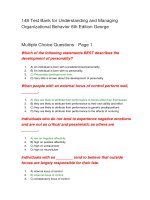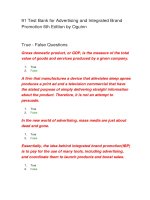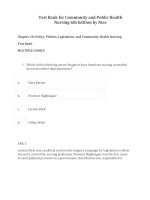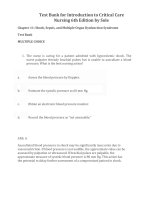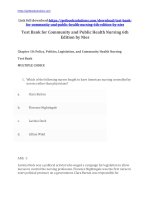Test bank for community and public health nursing 6th edition by nies
Bạn đang xem bản rút gọn của tài liệu. Xem và tải ngay bản đầy đủ của tài liệu tại đây (650.72 KB, 38 trang )
Link full download: />
Test Bank for Community and Public Health Nursing 6th
Edition by Nies
Chapter 10: Policy, Politics, Legislation, and Community Health Nursing
Test Bank
MULTIPLE CHOICE
1. Which of the following nurses fought to have American nursing controlled by
nurses rather than physicians?
a.
Clara Barton
b.
Florence Nightingale
c.
Lavinia Dock
d.
Lillian Wald
ANS: C
Lavinia Dock was a political activist who waged a campaign for legislation to allow
nurses to control the nursing profession. Florence Nightingale was the first nurse to
exert political pressure on a government. Clara Barton was responsible for
organizing relief efforts during the U.S. Civil War. Lillian Wald was the driving force
behind the federal government’s development of the Children’s Bureau in 1912.
DIF: Cognitive Level: Remember (Knowledge)
REF: p. 166
2. Which of the following nurses used political expertise to influence the federal
government to develop a Children’s Bureau?
a.
Clara Barton
b.
Florence Nightingale
c.
Lavinia Dock
d.
Lillian Wald
ANS: D
Lillian Wald recognized the connection between social conditions and health. She
was a driving force behind the federal government’s development of the Children’s
Bureau in 1912. Lavinia Dock was a political activist who waged a campaign for
legislation to allow nurses to control the nursing profession. Florence Nightingale
was the first nurse to exert political pressure on a government. Clara Barton was
responsible for organizing relief efforts during the U.S. Civil War.
DIF: Cognitive Level: Remember (Knowledge)
REF: p. 166
3. Which of the following best describes the most important factor in
legislation?
a.
The amount of financing and lobbying behind each
choice
b.
The beliefs, attitudes, and values of the policy
c.
The preferences of the majority of American voters
d.
The president’s ongoing encouragement for one
particular choice
ANS: B
Public policy encompasses the choices made regarding goals, priorities, and how
resources are allocated. Policy choices reflect the values, beliefs, and attitudes of
those designing the policy. The influence of the president, preferences of Americans,
and amount of financing related to the legislation are not as important as the beliefs,
attitudes, and values of the policy.
DIF: Cognitive Level: Understand (Comprehension)
REF: pp. 166-167
4. Which of the following is accomplished through the use of public policy?
a.
Solutions to problems of public concern are
developed.
b.
A rational, logical problem-solving decision-making
process is implemented.
c.
Public safety nets for vulnerable populations are
created.
d.
Economic and business management principles are
applied.
ANS: A
The field of public policy involves the study of specific policy problems and
governmental responses to them. Political scientists involved in the study of public
policy attempt to devise solutions for problems of public concern. The use of public
policy may not involve the implementation of a logical problem-solving decisionmaking process. Public policy addresses more than safety nets for vulnerable
populations. Additional principles besides economics and business management are
applied through the use of public policy.
DIF: Cognitive Level: Understand (Comprehension)
REF: p. 167
5. Which of the following best describes why it is so difficult to change the
paradigm of health care from disease orientation to promoting health
orientation?
a.
The belief exists that those without insurance could
obtain insurance if they worked hard enough.
b.
People find it difficult to agree on what the ideal
paradigm should be.
c.
People realize the media have exaggerated the
problems that result from lack of insurance.
d.
Serious reallocation of resources would have to occur.
ANS: D
A shift in the paradigm would necessitate a substantial reallocation of resources
because the vast majority of health spending is currently directed to medical care
and biomedical research and reflects a viewpoint of health care as a commodity. The
allocation of resources has the most influence on creating a paradigm shift.
Individual opinions and the use of media do not play as great of role as where
resources are spent.
DIF: Cognitive Level: Understand (Comprehension)
REF: p. 168
6. Which of the following best describes how the government controls
conditions that individuals cannot?
a.
Appeals to the common sense and good nature of the
citizens
b.
Establishes social mores that enable groups to control
individuals’ behaviors
c.
Passes and enforces law
d.
Uses fear reinforced by police power
ANS: C
Government regulates conditions that individuals cannot control and provides
individual protection through a population-wide focus. These tasks are
accomplished through passage and enforcement of laws. These laws control
individuals’ behaviors, which may lead to the establishment of social mores and
common sense related to the laws that have been established.
DIF: Cognitive Level: Understand (Comprehension)
REF: p. 169
7. Which of the following statements best describes why the federal government
is unable to do whatever politicians currently in power want?
a.
The citizens would rise up in rebellion if actions were
outrageous.
b.
The lack of funds to implement actions are seen as
unreasonable by a majority of voters.
c.
Only the actions authorized by the Constitution are
legitimate.
d.
The states would rebel and withdraw from the union.
ANS: C
The federal government is a government of limited powers, which means that, for a
federal action to be legitimate, it must be authorized. Only those actions that are
within the scope of the Constitution, the supreme law of the land, are authorized.
Power of the states and citizens is limited under the overall umbrella of the federal
government. Funding is also controlled through the powers of the federal
government.
DIF: Cognitive Level: Understand (Comprehension)
REF: p. 170
8. Which of the following is the basis for any American citizen to feel
comfortable expressing an opinion on a political issue?
a.
Amendments to the Constitution
b.
Articles of the Constitution of the United States
c.
Declaration of Independence
d.
Gettysburg Address
ANS: A
Amendments to the Constitution, later known as the Bill of Rights, were added after
the original Articles of the Constitution were ratified. These amendments protect
individuals’ rights and freedoms. The Declaration of Independence announced the
freedom of America from the British Empire. The Gettysburg Address was a speech
given by President Abraham Lincoln following the Civil War.
DIF: Cognitive Level: Understand (Comprehension)
REF: p. 170
9. Which of the following best describes who has the authority to act in every
area except those specifically mentioned in the Constitution?
a.
Any individual citizen
b.
Federal government
c.
Local government
d.
State government
ANS: D
Any powers not delegated to the federal government are reserved for the states.
Thus, individual citizens, the federal government, and local governments are
excluded.
DIF: Cognitive Level: Understand (Comprehension)
REF: p. 170
10. Which of the following best describes how the local government is provided
authority?
a.
Through the ability to tax local residents to meet local
needs
b.
Through the people themselves who band together to
create the community
c.
Power delegated from the federal level to the local
level
d.
Power delegated from the states
ANS: D
States may delegate powers to the local government. Which powers they delegate
vary widely from state to state. The federal government does not directly delegate
power to the local level, this occurs through state government. Taxation and
creation of a community do not provide the local government with authority.
DIF: Cognitive Level: Understand (Comprehension)
REF: p. 170
11. Which of the following statements best describes how policies in the private
sector are different from policies in the public sector?
a.
Private sector policies are slow, deliberate, and
reactive to events.
b.
Private sector policies are determined by the opinions
and feelings of those employed in that sector.
c.
Private sector policies are based on economics and
market trends.
d.
Private sector policies are based on rational decision
making.
ANS: C
Private policy is largely influenced by theories of economics and business
management, including consumerism and market trends. Such policies can react
quickly and are often proactive. In comparison, public policies are slow and reactive,
and economics is just one of many factors involved. Public policies are determined
by voting shifts, electoral realignment, and term limits.
DIF: Cognitive Level: Understand (Comprehension)
REF: p. 171
12. The president was sent a bill that he did not really like, but he would have
been unpopular if he vetoed it, so he did nothing. Which of the following best
describes what will happen to the bill?
a.
The bill is dead.
b.
The bill returns to both houses to see if enough votes
can be obtained to pass the bill even without the
president signing the bill.
c.
The bill becomes law.
d.
The bill sits there until the president signs it or vetoes
it.
ANS: C
A bill that has been passed by the legislature goes to the president. The president
may sign it so it becomes law; however, if he neither signs nor vetoes it, the bill
becomes law by default.
DIF: Cognitive Level: Apply (Application)
REF: p. 172
13. The forces for the proposed bill are roughly as persuasive, powerful, and well
financed as the forces against the proposed bill. Which of the following
describes the most likely outcome?
a.
The bill will be debated through a public hearing.
b.
The bill will fail.
c.
The bill will pass.
d.
The bill will remain in the legislature until one side or
the other has a majority of votes.
ANS: B
It is far easier to defeat a bill than get one passed; therefore, the opposition always
has the advantage.
DIF: Cognitive Level: Apply (Application)
REF: p. 172
14. Which of the following statements best describe what happened to the
hospitals built or expanded by Hill-Burton Act funds?
a.
Many such hospitals have consolidated or closed.
b.
Not needing to expand, hospitals have used the funds
to upgrade their facilities.
c.
They have continued to use such funds to expand.
d.
When funding ceased, so did hospital expansion.
ANS: A
The Hill-Burton Act authorized federal assistance in construction of hospitals,
making hospitals more accessible. However, with the high cost of health care and
the decreasing lengths of stay and increasing use of primary care, many hospitals
are closing. Because hospitals have closed, they are not further expanding or
upgrading facilities.
DIF: Cognitive Level: Understand (Comprehension)
REF: p. 174
15. An individual has been terminated from his job and has lost his health
insurance. Which of the following federal laws allows him to continue his
insurance benefits for a specified period of time?
a.
Health Insurance Portability and Accountability Act of
1996 (HIPAA)
b.
Family Support Act of 1988
c.
Health Maintenance Organization Act of 1973 (HMO)
d.
Consolidated Omnibus Budget Reconciliation Act of
1985 (COBRA)
ANS: D
An important requirement of COBRA focuses on the problem of the loss of insurance
when a person loses his or her job. With the growing number of unemployed,
COBRA is even more important. Employers who terminate an employee must
continue benefits for the employee and dependents for a specified period of time if
the employee had health benefits before the termination. HIPPA offers protections
for patient privacy and confidentiality. The Family Support Act expanded coverage
for poor women and children and required states to extend Medicaid coverage for
12 months to families who have increased earnings but are no longer receiving cash
assistance. The HMO Act provides grants for HMO development.
DIF: Cognitive Level: Apply (Application)
REF: p. 175
16. Which of the following statements best describes an effect of the Welfare
Reform Act of 1996?
a.
Individuals who were required to obtain employment
lost their health coverage.
b.
Many were happy to be off the government dole and
self-supporting.
c.
Persons sought and obtained employment that often
included insurance benefits.
d.
The food stamp program decreased in size.
ANS: A
The law decreased the number of people on welfare and forced many individuals to
take low-paying jobs, many of which did not offer health insurance. Many
individuals, particularly women and children, subsequently lost Medicaid coverage.
DIF: Cognitive Level: Understand (Comprehension)
REF: p. 175
17. Which of the following best describes the history of the State Child Health
Improvement Act (SCHIP) of 1997?
a.
The law included goals and programs but no funding
to achieve them.
b.
The law received extensive support by both
Republicans and Democrats.
c.
The law was extended, not renewed by the Bush
administration, and then renewed by the Obama
administration.
d.
The law was passed by the majority of states but not
by the federal government.
ANS: C
The law was extended several times, and then it was not renewed by the Bush
administration. In January 2009, the law was renewed again by the Obama
administration.
DIF: Cognitive Level: Understand (Comprehension)
REF: p. 175
18. Which of the following best describes what happened after the Medicare
Modernization Act of 2003 was enacted?
a.
Additional restrictions in coverage were imposed.
b.
Experimental treatments were approved for
reimbursement.
c.
Reimbursement procedures became more efficient.
d.
A prescription drug benefit was added.
ANS: D
The Medicare Modernization Act of 2003 provides seniors and people living with
disabilities with some prescription drug benefit coverage, as well as more choices
and better benefits. The act did not impose additional restrictions to coverage,
approve experimental treatments, or provide efficiency with reimbursement
procedures.
DIF: Cognitive Level: Understand (Comprehension)
REF: p. 175
19. A nurse is employed by the state public health department. Which of the
following activities would she most likely complete?
a.
Set up a flu shot clinic at a neighborhood church
b.
Lobby for health care reform to cover more
preventive services
c.
Monitor the incidence of influenza in the state
d.
Serve as a volunteer for a state legislator’s campaign
ANS: C
One of the state health care functions is assessment of health needs based on
statewide data collection. This could be done by monitoring the incidence of
influenza in the state. Setting up a flu shot clinic would most likely be done at the
local level, while lobbying for health care reform would most likely be done at the
federal level. Serving as a volunteer for a campaign may be something a nurse would
do, but would not be specifically related to employment by the state public health
department.
DIF: Cognitive Level: Apply (Application)
REF: p. 176
20. It has been proposed that a new, better approach to health care be tested with
a small group to evaluate its effectiveness. Which of the following best
describes why this cannot be done?
a.
Any employment in the project would be only
temporary, so it would be difficult to find
professionals to staff the program.
b.
It is challenging to find appropriate sites located in the
target area from which to offer the pilot project
service.
c.
No one wants to accept free services if they include
being a guinea pig in a research project.
d.
Offering a service establishes a precedent and a sense
of entitlement, so it is difficult to discontinue the
program.
ANS: D
Once a direct health care service is offered, it is difficult to discontinue it. Existing
programs create tradition by establishing vested interest and a sense of entitlement.
DIF: Cognitive Level: Apply (Application)
REF: p. 177
21. Which of the following best describes the most crucial step in policy
formation?
a.
Convincing both political parties and independents to
support the proposed policy
b.
Defining the issue and placing it on the agenda for
possible action
c.
Determining who has vested interest in what aspects
of the policy
d.
Trying to simplify the proposed legislation so the
public will support it
ANS: B
How an issue is defined determines what the possible approaches to resolution
might be. With all the demands on legislators’ time, it is difficult for an issue to be
seen as important enough to have action taken. Defining the issue as crucially
important and worthy of a place on the agenda for possible action is the most
critical step.
DIF: Cognitive Level: Understand (Comprehension)
REF: p. 177
22. A nurse suggests to the students that they attend the local district nurses’
association meeting, where the nurse is an officer. Which of the following
provides the best rationale for this action?
a.
Meeting outside the clinical area allows for more
effective informal learning based on discussion and
interaction.
b.
Role models are typically the major influence on
nurses choosing to become politically active.
c.
Students are often given extra credit from their
instructor for such community involvement.
d.
Such groups want students to attend their meetings to
encourage them to join and to accept a committee
responsibility.
ANS: B
Professional groups do not usually accept students into membership (especially
since many students may want a different specialty practice). Nurses most often
identify positive role models as the major influence that assisted them to become
politically active. Therefore, mentorship at the student level up to the expert level is
important. Providing extra credit should not be the motivator for students to learn
from these role models. The learning that occurs is a formal learning process related
to learning more about political advocacy and something that is difficult to
demonstrate in a classroom environment.
DIF: Cognitive Level: Apply (Application)
REF: p. 178
23. Which of the following statements best describes why nurses are not more
effective in creating political change?
a.
Nurses are not listened to by politicians.
b.
Nurses are not perceived as leaders in the health care
field.
c.
Nurses do not act or do not agree on what changes are
needed.
d.
Nurses do not know how to negotiate, communicate,
and collaborate to create change.
ANS: C
Nurses know how to communicate, collaborate, negotiate, and serve as leaders who
can make themselves heard. However, the various nursing subgroups do not agree
on public policies.
DIF: Cognitive Level: Understand (Comprehension)
REF: p. 179
24. The local nursing association and the local medical association disagreed
vehemently on advanced practice nursing reimbursement. Which of the
following best describes why the two groups agreed to join a coalition to send
representatives to testify on a particular bill?
a.
Although there was disagreement, both groups agreed
to behave politely and professionally.
b.
Both associations had formed a coalition to
collaborate on a bill that would benefit patients.
c.
Because the legislators had asked both groups to
appear, the groups did not have a choice.
d.
The two groups were sharing costs and expenses, but
their testimony would give opposing viewpoints.
ANS: B
When two or more groups join to maximize resources, increasing their influence
and improving their chances of success in achieving a common goal, it is a coalition.
Professional groups often form coalitions to advance their shared interests.
DIF: Cognitive Level: Apply (Application)
REF: p. 179
25. A nurse is employed by the state nursing association to serve as a lobbyist.
Which of the following would be the most crucial task to achieve?
a.
Be seen as a reliable and credible source of accurate
information
b.
Convince colleagues in nursing to join their local
nursing organization and write to encourage
legislators to vote according to nurses’ goals
c.
Offer to make large donations to the legislator who
can forward nursing’s agenda
d.
Visit every single legislator so the nurse is recognized
in this role
ANS: A
An individual who establishes a reputation as a reliable and accurate resource as a
lobbyist has substantial influence. Certainly, it is also useful to convince colleagues
to join nursing organizations and write legislators or contribute to campaigns of
legislators supportive of nursing goals. Legislators rely on lobbyists to educate them
on issues. The official must trust the lobbyists to give accurate (though predictably
biased) information, which is timely and up to date.
DIF: Cognitive Level: Apply (Application)
REF: p. 180
26. A nurse represents the state professional association. Which of the following
actions would the nurse complete in relation to legislation?
a.
Be prepared to contribute to campaigns of legislators
who vote consistently with nursing goals
b.
Be prepared to confront verbally those on the
opposite side of legislative issues
c.
Be prepared to provide testimony and comment on
relevant issues
d.
Be prepared to visit schools of nursing to present
about the current legislative issues
ANS: C
Although a nurse might do any of the above, the most effective is to provide
testimony and comment on issues of importance to nursing. Contributing is
dependent on the financial resources of the nurse. Legislators often appreciate
volunteer hours spent on campaign tasks as much as sums of money. Giving
presentations to schools may be useful, but it may be assumed that most nursing
faculty can discuss legislative health issues. Verbal confrontations are not always
useful.
DIF: Cognitive Level: Apply (Application)
REF: p. 180
27. A nurse is unable to be actively involved in attending meetings at the state
level. Which of the following actions would be most useful for the nurse?
a.
Asking students to remain informed regarding
proposed legislation
b.
Communicating, with rationales, her stand on
proposed legislation to legislators
c.
Remaining uninvolved so incorrect information is not
inadvertently given
d.
Writing letters to the local newspaper asking nurses
to become involved
ANS: B
Grassroots cooperation can influence decisions. A high number of communications
from individual constituents via e-mail, telephone, or postal mail have great
influence.
DIF: Cognitive Level: Apply (Application)
REF: p. 180
28. A nurse states that he or she does not want to become involved in politics
because of family, school, work, and other commitments. Which of the
following would be the best reply to this statement?
a.
“Good for you. We should all stay out of such dirty
game playing!”
b.
“I am sorry to hear that but I do understand.”
c.
“It doesn’t matter; politics have nothing to do with
nursing practice.”
d.
“It won’t take much time to join ANA and pay dues so
their lobbyist can represent you.”
ANS: D
Some of the nursing organizations have full-time lobbyists who work in Congress,
including the American Nurses Association (ANA). These lobbyists help represent
the interests of nurses and society. Politics play a major role in nursing practice and
nurses should be encouraged to participate in organizations, even if it is through
paying dues, so that their voice can be represented.
DIF: Cognitive Level: Apply (Application)
REF: p. 180
29. Which of the following statements best describes why nurses should
contribute whenever possible to their state nursing association political
action committee (PAC)?

